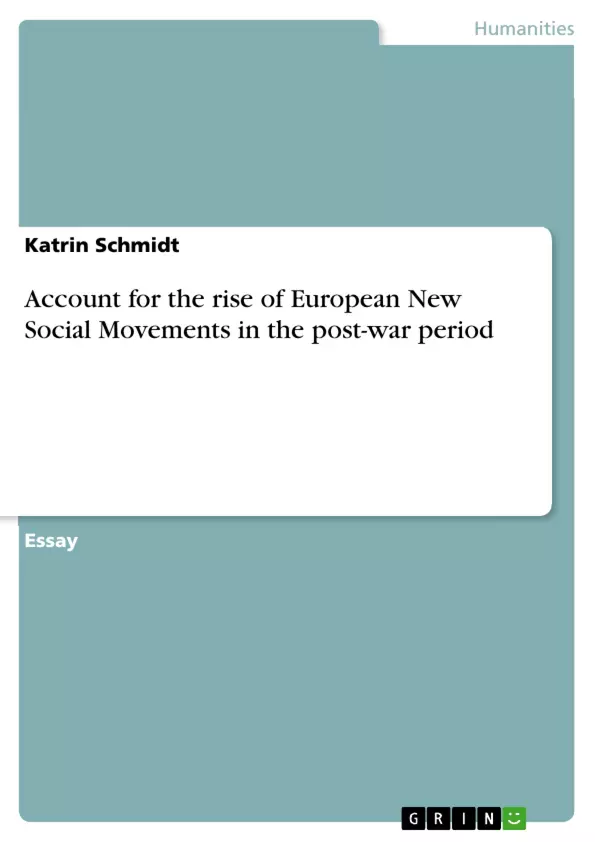The Civil Rights Movement in the USA, women’s movements all over the world, peace and anti-war movements, environmentalists, gay and lesbian rights groups… The rise and fall of various new social movements (NSM) can be observed throughout the last decades. But what is new about NSM compared to former social movements? Why did they rise in the post-war period? Why do people support a political cause? Why do they choose non-institutional means of influence?
This essay will define NSM in contrast to former social movements examining closely the post-war circumstances and the period’s impact on the rise of NSM all over Europe. The German green party Bündnis 90/Die Grünen (Die Grünen) will be pointed out as a special example of a NSM that became a party and therefore a political institution. The conclusion will focus on the rise and fall of NSM and give a future outlook.
Social movements are large informal groupings of individuals or organisations with a common interest, who focus on specific political or social issues to carry out a social change (see website 1). They are distinguished from other collective actors by having (the threat of) mass mobilisation as their prime source of social sanction, and hence of power (see Scott 1990, p.6).
Inhaltsverzeichnis (Table of Contents)
- The Civil Rights Movement in the USA, women's movements all over the world, peace and anti-war movements, environmentalists, gay and lesbian rights groups...
- Social movements are large informal groupings of individuals or organisations with a common interest, who focus on specific political or social issues to carry out a social change (see website 1).
- The term NSM refers to those movements which have come up in many western European societies since the mid-1960s.
- NSM's interpretations treat NSM as symptoms of the contradictions of the modern super-bureaucratic society for they express the tension between human autonomy and the growing regulation of post-industrial society (see website 2).
- New about NSM is a greater emphasis on collective identity and changes in lifestyle and culture rather than on developed ideologies and pushing for specific changes in public policy or economy.
- NSM can be subdivided into five categories of constraints: “values, past experiences, a constituency's reference group, expectations, and relations with target groups” (Freeman 1991, p.228).
- Modern societies do not have a clear centre which produces fixed identities, but rather a plurality of centres that produce a variety of flexible identities.
- The structure of NSM can be compared to networks and is less formal and hierarchical than the structure of the former social movements.
- The key actors of NSM are mainly members of the new middle class or service-sector professionals, e.g. academics (see website 3).
- From a socio-historical perspective Western Europe was conflict- and crisis-ridden.
- Between the 1960s and 1970s Europe became host of NSM which did not seem to fit Marxian class conflict - the predominant model in European social movement theory.
- NSM theory is a European model in the sense that it is rather based on disruption than on theory and that society moves from an industrial to a post-industrial context with the help of a post-materialist movement that arises out of old socialist movements (see Herrick 1995).
- The Western European countries share a structuralist-Marxist perspective - in contrast to a rational-functionalist perspective that is predominant in the USA - and therefore a deep history of anti-capitalist thought and action.
Zielsetzung und Themenschwerpunkte (Objectives and Key Themes)
This essay examines the emergence of New Social Movements (NSM) in post-war Europe, distinguishing them from earlier social movements and exploring the factors contributing to their rise. The essay delves into the specific case of the German Green Party, Bündnis 90/Die Grünen, as an example of a NSM transitioning into a political institution. The conclusion will discuss the rise and fall of NSM and offer a future outlook.
- Defining NSM in contrast to traditional social movements
- Analyzing the post-war context and its influence on the rise of NSM in Europe
- Exploring the characteristics and structures of NSM, including their focus on identity, lifestyle, and cultural change
- Examining the role of key actors, particularly the new middle class and younger generations
- Investigating the socio-historical and economic factors contributing to the rise of NSM
Zusammenfassung der Kapitel (Chapter Summaries)
The essay begins by introducing the concept of NSM and contrasting them with traditional social movements. It highlights the key characteristics of NSM, including their emphasis on collective identity, lifestyle, and cultural change, their focus on universal human interests, and their non-institutional forms.
The essay then explores the historical and social context surrounding the rise of NSM in post-war Europe. It examines the impact of the war, the rise of the welfare state, and the growth of higher education on the development of NSM. The essay also explores the role of key actors, particularly members of the new middle class and younger generations, in shaping NSM.
The essay delves into the theoretical frameworks surrounding NSM, including the post-materialism hypothesis and the structuralist-Marxist perspective. It examines the relationship between NSM and the broader social and economic changes occurring in post-war Europe.
The essay concludes by discussing the future of NSM, considering the challenges and opportunities they face in a changing world. It also reflects on the legacy of NSM and their impact on contemporary society.
Schlüsselwörter (Keywords)
This essay focuses on New Social Movements (NSM), post-war Europe, social change, cultural change, collective identity, lifestyle, non-institutional forms, post-materialism, the new middle class, young generations, structuralist-Marxist perspective, and the German Green Party (Bündnis 90/Die Grünen).
- Quote paper
- Katrin Schmidt (Author), 2006, Account for the rise of European New Social Movements in the post-war period, Munich, GRIN Verlag, https://www.grin.com/document/94227



